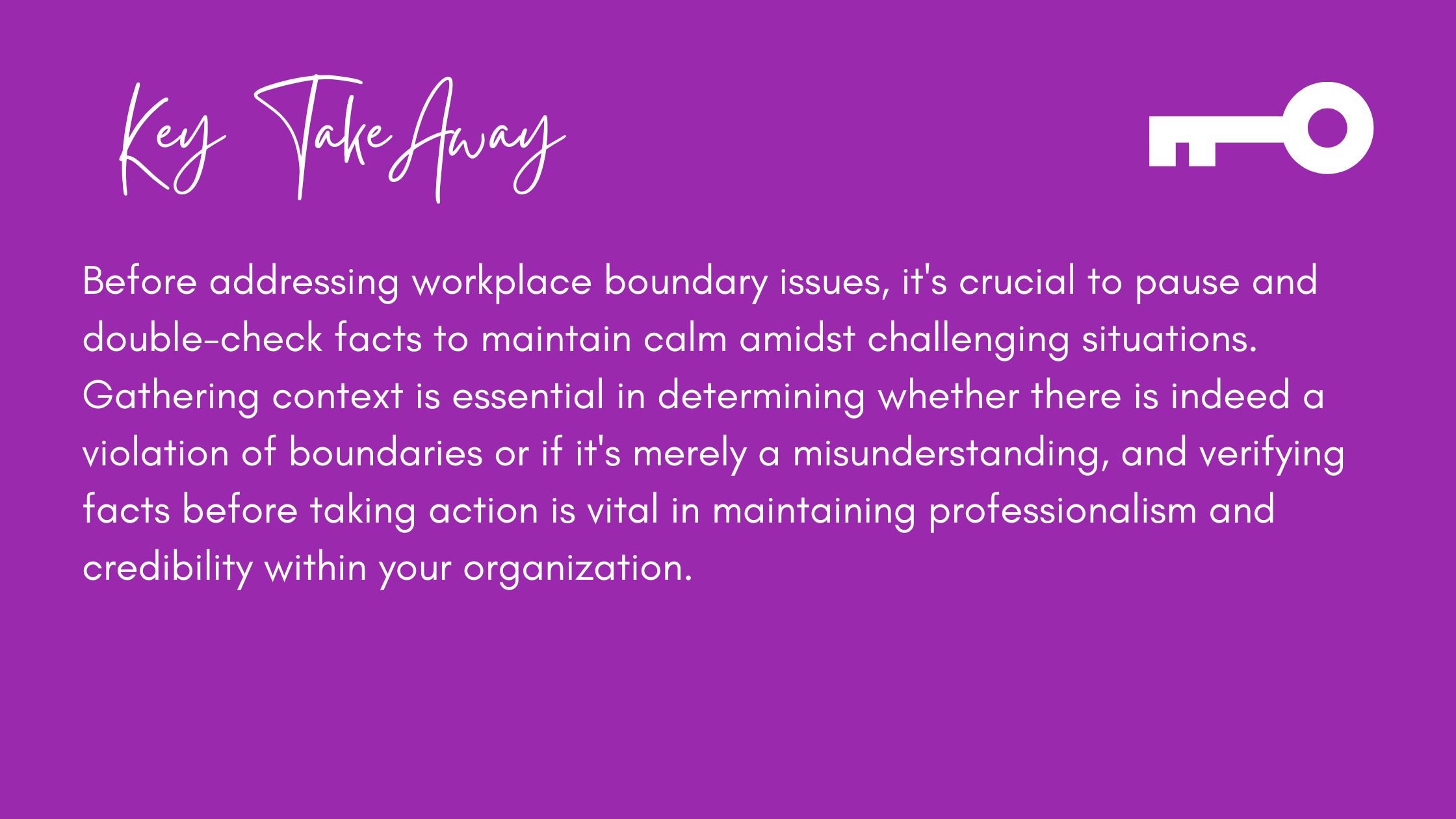Setting Boundaries at Work: Conscious Leadership Tips
Setting boundaries at work is an essential aspect of maintaining a healthy and productive professional life. Navigating the contemporary, competitive workplace can be tough, requiring a delicate balance between meeting demands and looking after one's own wellbeing. This blog post aims to provide valuable insights on how to effectively set boundaries in various work situations.
Throughout this post, we will explore strategies such as mastering the art of pausing and double-checking before taking action, reframing confrontation as feedback for better communication, and choosing your battles wisely. Additionally, we will discuss seeking guidance from trusted colleagues and escalating issues only when absolutely necessary.
Finally, we will introduce an effective career mapping tool that focuses on identifying personal competencies and leveraging them for success. By implementing these techniques in setting boundaries at work, you can navigate complex workplace dynamics with confidence while safeguarding your mental health and achieving professional growth.
The Art of Pausing and Double-Checking
Before addressing any workplace boundary issues, it's essential to pause and gather context. Understand the situation fully by double-checking facts and evidence before making accusations or escalating matters. This step allows you to establish or maintain your calm amidst challenging situations, while ensuring that you're acting on accurate information.
Gathering Context for a Clear Understanding of the Issue
To effectively address boundary concerns at work, take a moment to assess the situation from all angles. Consider factors such as communication breakdowns, cultural differences, or misinterpretations that may have contributed to the issue at hand. Understanding context is crucial in determining whether there is indeed a violation of boundaries or if it's merely a misunderstanding.
Importance of Verifying Facts Before Taking Action
In today's fast-paced corporate environment, misinformation can spread quickly and cause unnecessary conflicts. Therefore, verifying facts before taking action is vital in maintaining professionalism and credibility within your organization. For instance, consult with colleagues who were present during an incident or review email correspondence related to the matter for clarity.
Talk directly: Engage in open dialogue with those involved to gain their perspective on what transpired.
Analyze documentation: Review relevant documents such as meeting minutes or project plans that might shed light on potential misunderstandings.
Cross-reference information: Consult multiple sources when gathering data about an issue so as not to rely solely on one person's account.
By taking the time to pause and double-check, you can approach boundary issues from a well-informed standpoint. This not only ensures that your actions are based on accurate information but also demonstrates your commitment to resolving conflicts professionally and fairly.
Reframing Confrontation as Feedback
Confrontation doesn't have to be a dirty word. In fact, it can be an opportunity for growth and setting expectations. By approaching it with integrity and calmness, you can demand respect in the world of work, no matter your level or role. Here's how to model appropriate behavior when confronting others professionally.
Embracing Confrontation as Constructive Communication
Confrontations are often seen as negative, but they can be valuable opportunities for growth if approached constructively. When addressing boundary issues at work, consider adopting the mindset that confrontation is simply giving or receiving feedback. By approaching confrontation as a chance to provide and receive feedback, both parties can focus on finding solutions instead of getting caught up in emotions or defensive postures.
Stay calm: Take deep breaths and keep your tone even.
Be specific: Clearly articulate the issue at hand without making assumptions.
Acknowledge their perspective: Show empathy by acknowledging their viewpoint before presenting yours.
Establishing Clear Expectations Through Honest Dialogue
To set boundaries effectively at work, it's essential to establish clear expectations through honest communication with colleagues. Here are some tips for initiating productive conversations:
Pick the right time and place: Choose a private setting, free from distractions where you can have a focused conversation.
Use "I" statements: Frame your concerns using phrases like "I feel" or "I think."
Offer solutions: Suggest potential resolutions that can benefit all parties involved.
Incorporating these strategies into workplace confrontations will help you reframe them as opportunities for feedback and growth. By fostering an environment where honest communication is encouraged, you'll be better equipped to navigate challenges while commanding respect from colleagues. Remember, setting boundaries at work starts with having the courage to speak up and engage in constructive conversations - it's an essential skill for any successful professional.
Choosing Your Battles Wisely
Not every conflict is worth fighting over; therefore, it's crucial to choose your battles wisely to maintain professionalism at work. Determine which issues are significant enough to address while avoiding unnecessary conflicts that could harm your reputation or relationships with colleagues.
Identifying Priority Conflicts Requiring Attention
Recognizing when to intervene and when it's better to overlook certain matters is an important part of managing conflict. To identify priority conflicts, consider the following factors:
Impact on job performance: If the issue directly affects your ability to perform tasks effectively or achieve goals, it should be addressed promptly.
Misalignment with company values: When someone's actions contradict the organization's core principles, taking action is advisable to preserve those principles’ integrity.
Potential for escalation: Some disputes may worsen or set a negative precedent if left unaddressed and can lead to more severe consequences down the line. In such cases, timely intervention is highy recommended.
Evaluating these aspects will help you determine whether a conflict merits attention or if it can be safely ignored without causing further problems.
Avoiding Minor Disputes to Protect Your Professional Reputation
To maintain a positive professional image and healthy working relationships with colleagues, avoid engaging in petty arguments that don't contribute meaningfully towards resolving issues. Instead of getting involved in less significant disputes:
Focus on finding solutions collaboratively and addressing the root causes of disagreements.
Practice empathy by putting yourself in others' shoes, understanding their perspectives, and working towards a common goal.
Develop emotional intelligence skills, such as self-awareness, self-regulation, motivation, empathy, and social skills to navigate workplace conflicts effectively.
By choosing your battles wisely and focusing on constructive problem-solving approaches instead of engaging in unproductive disputes, you'll be better equipped to protect your professional reputation while fostering a positive work environment for all involved parties.
Seeking Guidance from Trusted Colleagues
By drawing on the wisdom of trusted colleagues, one can gain insight into establishing appropriate workplace boundaries and make decisions that protect their professional standing. Trusted colleagues can offer valuable input based on their experience and help you navigate challenging situations with confidence while preserving your professional standing.
Leveraging Collective Wisdom for Better Decision-Making
Collective wisdom is powerful in making informed decisions about workplace boundaries. Seek guidance from those who have faced similar challenges or possess relevant expertise to gain insights that may not be immediately apparent to you alone. When approaching colleagues for advice, present your concerns objectively and listen carefully to their suggestions.
Ask open-ended questions: Encourage thoughtful responses by asking questions that allow them to share their experiences and perspectives freely.
Show appreciation: Express gratitude for their time and willingness to assist you in navigating complex issues; reciprocate when possible.
Maintain confidentiality: Respect the privacy of your colleagues by keeping conversations confidential unless they explicitly grant permission otherwise.
Building Supportive Networks Within the Workplace
Fostering strong relationships with coworkers is an invaluable asset when addressing boundary-related concerns at work. A supportive network provides emotional encouragement and practical assistance in resolving conflicts effectively. Here are some tips on building such networks within your workplace:
Create opportunities for collaboration: Seek out projects or tasks that require teamwork to form connections with colleagues who share similar goals and values.
Participate in company events: Attend social gatherings, training sessions, and other activities organized by your employer to expand your professional circle.
Mentorship programs: Consider participating in a mentorship program, either as a mentor or mentee, to foster lasting relationships within the organization.
Remember, having a support system and building strong relationships with colleagues can help you manage workplace boundaries with confidence.
Escalating Issues When Necessary
Dealing with boundary transgressions at work can be tricky. Sometimes, direct communication just doesn't cut it. When the situation requires it, take appropriate steps to address the issue. But how do you know when it's time to take things up a notch?
Knowing When to Escalate
If you've tried talking to the person(s) involved and the problem persists, it's time to escalate. Repeated boundary violations or feeling unsafe are clear signs that you need to take action.
Utilizing Resources for Conflict Resolution
Don't worry, you're not alone. Your organization should have the resources to assist you in managing conflicts equitably. Here are a few:
Human Resources (HR): They're not just there to hire and fire. HR can investigate and mediate conflicts and ensure company policies are honored.
Ethics Hotline: If your company has one, use it. You can report unethical behavior or policy violations anonymously.
Mentors/Sponsors: They've been around the block and can help you navigate tricky situations.
Ombudsman: Some companies have a neutral third party who can help resolve conflicts and address employee concerns.
Remember, setting boundaries at work is important for your well-being. If needed, don't hesitate to take the necessary steps for resolution. By utilizing available resources, you can ensure that your concerns are addressed effectively.
Career Mapping Tool for Success
Empower yourself at work by setting boundaries and utilizing a career mapping tool. This tool helps you uncover your unique competencies and strengths, creating a clear path to navigate workplace challenges while commanding respect from colleagues.
Identifying Personal Competencies and Leveraging Them
Evaluate the behaviors, aptitudes and capabilities that make you stand out from the crowd. These personal and professional competencies can range from functional or technical expertise, to leadership competencies such as strategic thinking and problem solving. Focus on developing these areas even further so they become assets in the workplace.
Designing a Successful Career Map Based on Individual Strengths
Create an effective career map by outlining short-term and long-term objectives within your chosen field or industry. Assess where you stand professionally compared with where you want to be, identify gaps, and break down each goal into smaller tasks that will lead towards its achievement. Be prepared for unexpected changes and regularly review and update your career map to ensure it remains relevant.
By using a career mapping tool, you can align your unique competencies with the needs of your organization. This alignment will help you excel in your current role and position yourself for future opportunities within the company. Additionally, having a clear understanding of where you want to go professionally will enable you to set boundaries at work more effectively, ensuring that others respect both your time and expertise.
Incorporate these strategies into your professional life to empower yourself and foster positive relationships with colleagues who recognize and value what makes you uniquely qualified for success in today's competitive corporate landscape.
Conclusion
By pausing and double-checking, reframing confrontation as feedback, and choosing battles wisely, individuals can establish clear expectations and protect their professional reputation.
Seeking guidance from trusted colleagues and utilizing career mapping tools can also aid in achieving goals and fostering positive relationships with coworkers.
Remember, setting boundaries requires honest communication and a willingness to seek help when needed.
Follow these tips to create a more productive and fulfilling work environment.






